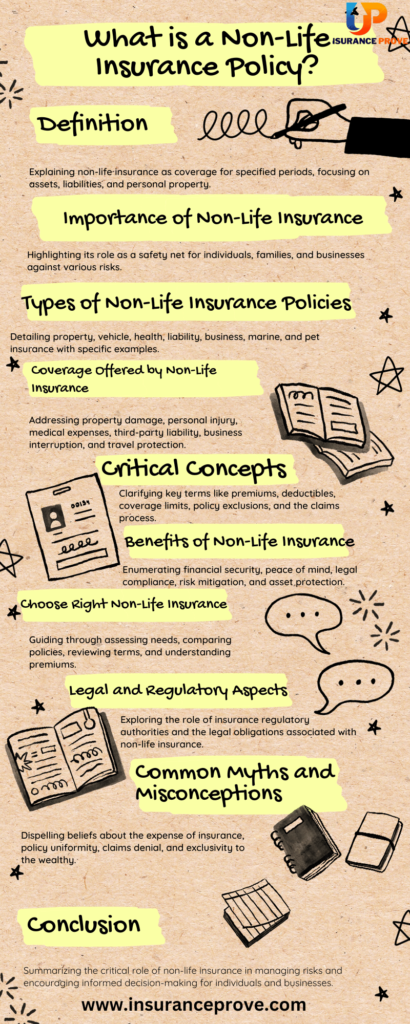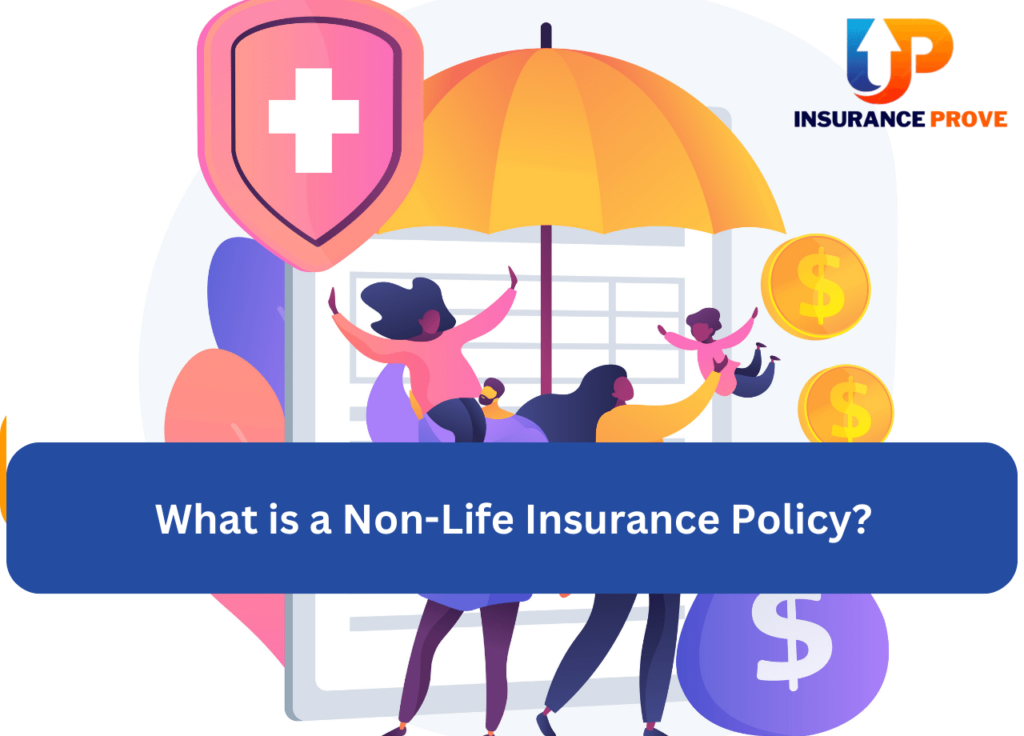Non-life insurance, often called general insurance, is a vital financial tool that offers protection against a wide range of risks. This comprehensive article will shed light on What is Non-Life Insurance Policy? and cover their various aspects, benefits, and common misconceptions.
Definition of Non-Life Insurance
Non-life insurance, also known as general insurance, is a policy that provides coverage for a specified period to protect against financial losses resulting from unforeseen events. Unlike life insurance, which focuses on the insured’s life, non-life insurance primarily deals with assets, liabilities, and personal property.
Importance of Non-Life Insurance
Non-life insurance is paramount as it is a safety net for individuals, families, and businesses. It protects against various risks, from property damage and personal injury to legal liabilities. Without non-life insurance, the financial consequences of such events can be overwhelming.
Types of Non-Life Insurance Policies
Property Insurance
Property insurance is a broad category that includes policies designed to protect various types of assets, such as homes and commercial properties.
Home Insurance
Home insurance, a subset of property insurance, safeguards homeowners against property damage, theft, and personal liability. It is a critical shield for one’s most valuable asset.
Commercial Property Insurance
For businesses, commercial property insurance is essential. It covers the physical structure of a company, equipment, inventory, and more against damage or loss.
Vehicle Insurance
Vehicle insurance is a common type of non-life insurance that offers protection for various kinds of vehicles.
Car Insurance
Car insurance provides:
- Automobile coverage.
- Ensuring financial support in the event of accidents.
- Theft.
- Damage to the insured vehicle.
Two-Wheeler Insurance
Two-wheeler insurance is designed for motorcycles and scooters. It offers protection similar to car insurance but tailored to the unique needs of two-wheeled vehicles.
Health Insurance
Non-life insurance extends to health coverage, ensuring individuals receive financial support for medical expenses, treatments, and hospitalizations.
Travel Insurance
Travel insurance is indispensable for globetrotters, protecting against trip cancellations, medical emergencies abroad, and loss of belongings.
Liability Insurance
Liability insurance protects policyholders from financial obligations resulting from legal claims or lawsuits, including personal and professional liability.
Business Insurance
Business or commercial insurance shields businesses from various risks, including property damage, liability claims, and business interruption.
Marine Insurance
Marine insurance covers goods, cargo, and vessels during transit, safeguarding against losses in the shipping industry.
Pet Insurance
Pet insurance covers veterinary expenses and potential liabilities for pet owners.

Coverage Offered by Non-Life Insurance
Property Damage
Non-life insurance policies often cover property damage from natural disasters, accidents, or other unforeseen events.
Personal Injury
Personal injury coverage provides financial support to policyholders for medical expenses and loss of income resulting from injuries.
Medical Expenses
Health insurance policies under non-life insurance offer comprehensive coverage for medical treatments and hospitalization costs.
Third-Party Liability
Liability insurance includes third-party liability coverage, which protects policyholders from financial responsibility in the event of damage or injuries to others.
Business Interruption
Business insurance policies cover financial losses from business interruptions, such as natural disasters or accidents.
Travel Protection
Travel insurance policies encompass various forms of protection, including trip cancellation, lost luggage, and emergency medical expenses.
Critical Concepts in Non-Life Insurance
Premiums
Premiums are the periodic payments made by policyholders to maintain their insurance coverage. These payments vary based on the type of insurance, coverage amount, and other factors.
Deductibles
Deductibles are the out-of-pocket expenses that policyholders must pay before insurance coverage. Higher deductibles often lead to lower premium costs.
Coverage Limits
Coverage limits define the maximum amount an insurance policy will pay out in the event of a claim. It’s essential to understand these limits to ensure adequate coverage.
Policy Exclusions
Policy exclusions outline specific events or circumstances not covered by the insurance policy. Policyholders should be aware of these exclusions to avoid misunderstandings.
Claims Process
Understanding the claims process is crucial. It involves reporting an incident, documenting the damages, and working with the insurer to achieve a fair settlement.
Benefits of Non-Life Insurance
Financial Security
Non-life insurance offers financial security, ensuring policyholders receive financial support when unexpected events occur.
Peace of Mind
Non-life insurance provides peace of mind, knowing one is protected against unforeseen financial burdens.
Legal Requirements
Certain types of non-life insurance, such as car insurance, are mandatory by law, ensuring compliance with legal requirements.
Risk Mitigation
Non-life insurance helps mitigate risks by providing a safety net for various life events, such as accidents or property damage.
Asset Protection
Insurance policies protect assets, whether home, vehicle, or business, from financial loss.
How to Choose the Right Non-Life Insurance
Assessing Your Needs
Evaluating your specific needs and the risks you face is the first step in choosing the right non-life insurance policy.
Comparing Policies
Comparing policies from different insurers helps you find the coverage that best suits your requirements and budget.
Reviewing Policy Terms
Carefully reviewing policy terms and conditions is essential to understanding what is covered, the coverage limits, and any policy exclusions.
Understanding Policy Premiums
Factors Affecting Premiums
Premiums are influenced by various factors, including the type of insurance, coverage amount, deductible, and the policyholder’s risk profile.
Premium Payment Options
Policyholders often have multiple premium payment options: monthly, quarterly, or annual. Understanding these choices is essential for budgeting.
Claims Process in Non-Life Insurance
Filing a Claim
In the event of an incident, policyholders must promptly file a claim with their insurer, providing details of the loss or damage.
Documentation Requirements
Accurate and thorough documentation of damages, injuries, and expenses is vital to support your claim.
Claim Settlement
The claims process involves an investigation by the insurer, and upon approval, a settlement is offered to the policyholder.

Common Myths and Misconceptions
Insurance Is Expensive
It dispels the myth that insurance is prohibitively expensive and highlights many policies’ affordability.
All Policies Are the Same
They address the misconception that all insurance policies are identical, emphasizing the importance of selecting coverage tailored to your needs.
Insurers Deny All Claims
They are correcting the belief that insurers routinely deny claims and highlighting the fair and transparent claims process.
Insurance Is Only for the Wealthy
I emphasize that insurance is not limited to the wealthy and is accessible to individuals and businesses of all financial backgrounds.
Legal and Regulatory Aspects
Insurance Regulatory Authority
We are highlighting the role of insurance regulatory authorities in ensuring the fairness and transparency of the insurance industry.
Compliance and Legal Obligations
We explained the legal obligations and compliance requirements associated with non-life insurance policies.
Case Studies
Real-Life Scenarios
They presented real-life scenarios where non-life insurance was pivotal in mitigating financial losses and providing support.
Successful Insurance Stories
They shared success stories of individuals or businesses benefiting from their non-life insurance policies.
Future Trends in Non-Life Insurance
Technological Advancements
We are exploring the role of technology in enhancing the efficiency and accessibility of non-life insurance.
Changing Customer Expectations
Discuss how evolving customer expectations influence the development of insurance products and services.
Importance of Reviewing and Updating Policies
Annual Policy Review
We emphasize the importance of regularly reviewing and updating insurance policies to meet changing needs and circumstances.
Policy Enhancements
we are highlighting the option to enhance policy coverage or add endorsements to protect against evolving risks.
Conclusion
The Role of Non-Life Insurance in Risk Management
They summarize the critical role of non-life insurance in managing and mitigating various risks that individuals and businesses face.
Making Informed Insurance Choices
They encourage readers to make informed decisions when selecting non-life insurance, considering their unique needs and circumstances.
FAQs (Frequently Asked Questions) About Non-Life Insurance
What is non-life insurance, and how does it differ from life insurance?
Non-life insurance, or general insurance, covers various risks and events during a specific policy term. It differs from life insurance, which primarily covers the insured’s life and pays a death benefit to beneficiaries. Non-life insurance focuses on assets, liabilities, and property.
What types of insurance fall under the category of non-life insurance?
Non-life insurance encompasses various types, including property insurance (home and commercial), vehicle insurance (car and two-wheeler), health insurance, travel insurance, liability insurance, business insurance, marine insurance, and pet insurance.
How do non-life insurance policies benefit policyholders?
Non-life insurance offers several benefits, including financial security, peace of mind, legal compliance, risk mitigation, and asset protection. It ensures that policyholders receive financial support during unforeseen events, reducing the economic impact of accidents, property damage, or legal liabilities.
What are the key terms to understand when dealing with non-life insurance?
Key terms in non-life insurance include:
Premiums (periodic payments).
Deductibles (out-of-pocket expenses before coverage kicks in).
Coverage limits (maximum payout amounts).
Policy exclusions (events not covered).
The claims process (reporting incidents, documentation, and settlement).
Are non-life insurance policies mandatory, or are they optional?
The mandatory nature of non-life insurance policies depends on the type and local regulations. For example, car insurance is often compulsory by law, while other types, like home or travel insurance, are typically optional. It’s essential to check local laws and requirements.
How can I choose the right non-life insurance policy for my needs?
Selecting the right non-life insurance policy involves:
Assessing your needs.
Comparing policies from different insurers.
Carefully reviewing policy terms and conditions.
It’s crucial to choose coverage that aligns with your unique circumstances.
What factors affect non-life insurance premiums?
Non-life insurance premiums are influenced by several factors, including the type of insurance, coverage amount, deductible, and the policyholder’s risk profile. Premiums vary based on these elements; understanding them is vital for budgeting.
What is the process for filing a claim in non-life insurance?
Filing a claim in non-life insurance involves:
Reporting the incident to your insurer.
Documenting damages or expenses.
Working with the insurer’s claims department to facilitate a fair settlement.
The specific process may vary depending on the type of
Are there any common myths or misconceptions about non-life insurance?
Yes, there are several common misconceptions about non-life insurance, such as the belief that insurance is always expensive, all policies are the same, insurers deny all claims, or that insurance is only for the wealthy. This article dispels these myths and provides a clearer understanding of the insurance landscape.
How often should I review and update my non-life insurance policies?
Reviewing and updating your non-life insurance policies annually or whenever significant life changes occur, such as buying a new home or vehicle, is recommended. Regular policy reviews ensure your coverage aligns with your evolving needs and circumstances.
What is Non-Life Insurance Policy?
A Non-Life Insurance Policy, or general insurance, covers various risks and events during a specific policy term, excluding coverage for the insured’s life. It protects assets, liabilities, and personal property from unforeseen circumstances, such as accidents, damage, or legal penalties.
These FAQs offer valuable insights into “What is Non-Life Insurance Policy?” helping readers understand its nuances and make informed decisions when choosing the right coverage for their situations.